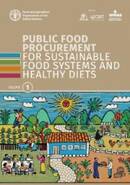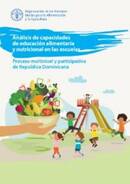Publications
Sustainable Public Food Procurement (PFP) represents a key game changer for food systems transformation. It can influence both food consumption and food production patterns. It can deliver multiple social, economic, and environmental benefits towards sustainable food systems for healthy diets.
This publication aims to contribute to the improved understanding, dissemination, and use of PFP as a development tool in particular in the case of school meals programmes.
In Volume 1, researchers, policymakers, and development partners can find evidence on how PFP can be used as a development tool and deliver multiple benefits for multiple beneficiaries. It argues that PFP can provide a market for local and smallholder farmers, promote the conservation and sustainable use of agrobiodiversity, and improve the nutrition and health of children and communities.
Volume 2 of this publication, available at https://doi.org/10.4060/cb7969en presents further analysis of the instruments, enablers and barriers for PFP implementation. It also provides case studies with local, regional and national experiences from Africa, Asia, Europe and North and South America.
Sustainable Public Food Procurement (PFP) represents a key game changer for food systems transformation. It can influence both food consumption and food production patterns. It can deliver multiple social, economic, and environmental benefits towards sustainable food systems for healthy diets.
This publication aims to contribute to the improved understanding, dissemination, and use of PFP as a development tool in particular in the case of school meals programmes. In this Volume 2, researchers, policymakers, and development partners can find extensive evidence of the instruments, enablers, and barriers for PFP implementation. It also provides case studies with local, regional, and national experiences from Africa, Asia, Europe, and North and South America.
Volume 1 of this publication, available at https://doi.org/10.4060/cb7960en, presents further analysis on how PFP can be used as a development tool and deliver multiple benefits for multiple beneficiaries. It argues that PFP can provide a market for local and smallholder farmers, promote the conservation and sustainable use of agrobiodiversity, and improve the nutrition and health of children and communities.
FAO ha desarrollado una herramienta para realizar un análisis de capacidades en educación alimentaria y nutricional para las escuelas, que permita identificar los principales desafíos para que la EAN se realice de manera eficaz. Esta herramienta permite facilitar a los países dónde se aplica, una ruta estratégica de acciones priorizadas para llevar a cabo esfuerzos en materia de EAN de una manera efectiva y sostenible,y que responda a la institucionalidad del país. En este contexto desde la Iniciativa regional 1 de FAO en ALC: Sistemas alimentarios sostenibles a fin de proporcionar dietas saludables para todos, quiere desarrollar esta herramienta en distintos países de la región de forma que los tomadores de decisiones tengan un análisis de capacidades en EAN para los CE y puedan desarrollar planes, estreatgías políticas adecuadas a las circunstancias. El primer país en el que se desarrolló este proceso fue en República Dominicana donde a pesar de realizar el estudio durante la época de la pandemis hubo mucha aceptación y participación de los distintos actores convocados.
Se identifica como fortaleza del estudio que recoge los grandes aprendizajes, los aportes, opiniones y principales limitaciones, y soluciones priorizadas para abordar la EAN. El objetivo de este documento es servir como herramienta para orientar acciones en EAN en sintonía con el contexto y la realidad de Repúiblica Dominicana, y que pueda ha servido de ejemplo para ser replicable en otros países de la región. De esta forma, a través del estudio se apoya el el avance del cumplimiento del ODS 2 y asegurar una alimentación saludable de los niños y niñas de la subregión, garantizando una vida sana, próspera e inclusiva social y productivamente a través de la educación.
The capacity needs assessment tool is meant to be used by national and local groups as a foundation for the design of school-based food and nutrition education capacity development strategies. The tool builds on FAO’s experience and expertise in capacity development, and adopts a broad approach that not only assesses capacities at the individual level, but also expands to the level of organizations and the enabling environment.
The first live broadcast Learning Route “Successful practices, tools and mechanisms to design, implement and monitor Home-Grown School Feeding (HGSF) programmes in Africa” jointly promoted by the Food and Agriculture Organization of the United Nations (FAO) and Procasur took place from the 7th to the 12th of December 2020 in Kenya. Twenty-two government officials and decision-makers attended this Learning Route; amongst them: seven (07) Kenyan government officials travelled from Nairobi to Busia and Siaya Counties to visit and share knowledge with local HGSF initiatives, such as: the BFN Project developed in Busia and the Nyamninia Primary school in Siaya County. The remaining fifteen participants from selected African countries (Burkina Faso, Cameroon, Egypt, Ghana, Lesotho, Rwanda and Uganda) experienced the same learning journey on a virtual modality through live broadcast connections and direct interactions with key actors in the field.
Kenya thanks to its well-established HGSF model was an inspiring host, showcasing the differentiated approaches and strategies developed at national level to facilitate small farmers’ inclusion in the school meals. The “direct cash transfers to school” as a food procurement mechanism, the multisectoral and multi-actors engagement, the nutritional and biodiverse provision of school meals are some of the innovations analyzed during the Learning Route. This final report presents main lessons extracted during the case analysis workshops as well as innovative solutions that participating African Governments intend to adopt and scale-up in their respective countries as a follow-up of their participation to the learning route.





